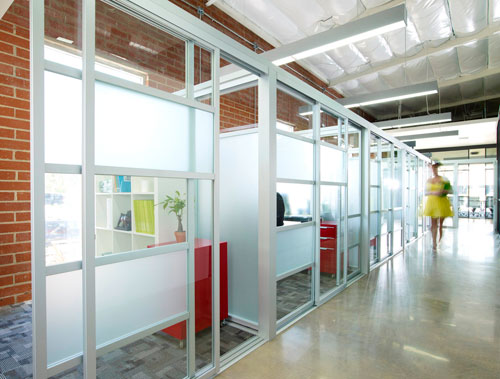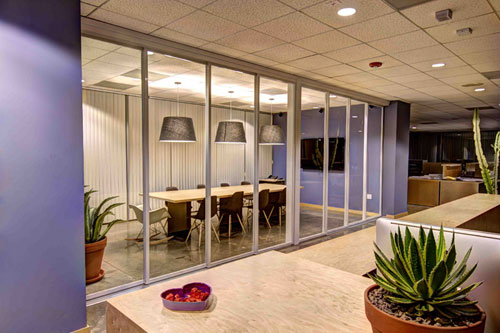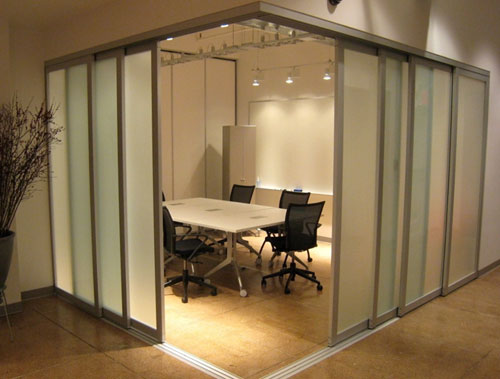Light and Truth: Greener Interiors with Glass Partitions
For that reason, portable office elements such as “knockdown storefront systems” are even more appealing, says Franz, because they can be dismantled and moved to the next space. This dovetails nicely with the U.S. Green Building Council’s LEED certification program and other standards, such as the International Green Construction Code (IGCC), which reward the use of demountable, moveable building systems as well as interior glass panels. In addition, there are opportunities for improved project scheduling and staging that may be advantageous. Last, the wall systems – like furniture – can be depreciated more rapidly, a benefit at tax time.
 |
The use of consecutive partitions appear as an interior storefront system, yet can still be dismantled and moved to another building or space. LEED and IGCC certifications may offer credits for using demountable, moveable building systems as well as interior glass panels. |
The value of using prefabricated glass walls and sliding doors has migrated to multifamily and hotel room interiors, where they help open up the spaces, bring in daylight and views, while still providing privacy and acoustical separation.
| Construction and ROI: More Benefits for Glass Partition Systems |
||||||||||||||||
Glass partition systems with sliding doors visually open up building interiors, giving more building occupants exposure to windows and view. Other benefits drop to the bottom line, providing quantifiable return on investment (ROI):
|
The inner glass envelope
More than anything else, glass walls bring the opportunity for layered spatial programming relative to the building envelope. This means that a glass partition layer may be introduced inboard of the perimeter walls, to provide a new use area without reducing daylight penetration or views to outdoors.
The result – an inner glass envelope, so to speak – is one of the architectural and space-planning trends of contemporary architecture. Office buildings increasingly feature an open-plan work area at the building perimeter, lined by glass-fronted enclosed offices that may back up to the circulation core. In hotel guestrooms and multifamily units, often the unit layout is a narrow, deep volume with one or more end-windows at the perimeter. Using glass partitions, daylight from the perimeter area carries deeper into the volume, toward the center of the building. Shared areas may enjoy proximity to windows while bedrooms, kitchens and even bathrooms sit behind glass walls, private and separate yet united by sunlight and view.
 |
Sliding door assemblies on the modular glass-and-aluminum partition systems can be either a bottom floor-track rolling systems or top-hung suspended doors. |
Other building types can also benefit from this, such as buildings where a “sterile corridor” or separated viewpath needs visual access to other building activities. Examples include laboratories, schools, and industrial settings.
Specifying glass interior partitions
While these layouts and capabilities are favored, there are many facets to the architect’s goal of opening and enlivening interior spaces. Properly designing and specifying the glass partitions and glass sliding doors is one of the key challenges.
When it comes to modular glass partition systems, the focus is on creating a robust, elegant wall that holds its value while performing properly. “Where durability matters, the commodity products sold at big-box stores are simply not up to the task,” says Schwartz. “Part of product selection is determining whether the system is suited to the use and the life cycle of the project.”
Application analysis. For projects using movable and demountable walls, architects need to analyze anticipated uses and the best options for flexibility. Doors and wall panels can be opened to let in light and air, or they can be closed for privacy. They can be integral to a total home design or commercial space plan to make the best use of large spaces.
Metal-framed glass walls can also be used to divide areas into new rooms, such as in lofts or other open-plan interiors, enhancing functionality. Workspaces created from sliding glass doors can provide flexibility for shared workplaces, satellite offices, as well as group conference nodes. Glass sliding doors create a larger sense of space and can be used in daylight harvesting strategies for greater access to views of nature.
These modular components replace traditional drywall partitions and other construction types that are less flexible, promoting change. Some typical applications and benefits include:
- Daylight harvesting.
- Maximizing space in small rooms.
- Modernization or rebranding of a business.
- Cost-effective upgrading or “refreshing” of the property’s image, for example at hotels, restaurants or offices where the changes are often needed every five to seven years.
- Instituting new workplace models to allow for more collaborative work, flexible work schedules or coworking, where individuals and groups office together even though they work on different projects or for different employers.
- Improving interior environmental quality (IEQ), to meet tenant and employee expectations for healthier air quality, increased access to daylight, reduced toxicity of materials and finishes, and flexibility of work and living space configurations.
 |
To accommodate new workplace needs, such as increased collaboration space or flexible meeting space, modular glass partitions offer flexibility and ease of installation. |









